Picto Diary - 28 September 2015 - The Battle of Loos
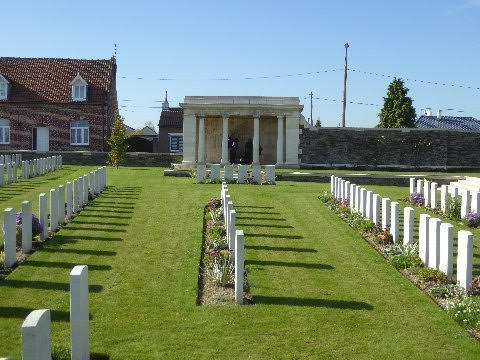
Above: Vermelles British Cemetery, Vermelles, France. 28 September 2015.
Vermelles was in German hands from the middle of October 1914 to the beginning of December 1914, when it was recaptured by the French. The cemetery was begun in August 1915, and during the Battle of Loos, when the town chateau was used as a dressing station. There are 2134 First World War casualties commemorated in the cemetery. Most of the Commonwealth war cemeteries were located in hospital/dressing stations for major battles.
In the image, in the monument at rear, battlefield guide Patrick Mercer overviews with our group the war to date from the British point of view.
Through the spring of 1915, from their entry into the war in mid-August, 1914, the British Expeditionary Force (BEF), had not been a significant force in the grand scheme of the war. The allies, the French, on the Western Front, and the Russians on the Eastern Front had borne the brunt of the casualties.
Battle of the Frontiers - Mons, and the Retreat
In mid-August,1914, the British had their first engagement with the Germans, at Mons, part of the Battle of the Frontiers. The Battle of the Frontiers was a series of engagements along a line from Belgium to Alsace Lorraine, fought between the Germans and the French.
On the allied right - The Ardennes, Alsace Lorraine - the French were learning that their war beginning offensive efforts to break the German line were not effective due to intense, accurate German artillery, the surprising efficacy of new machine guns, and overwhelming numbers of German troops put into the field. On the allied left - Belgium - , the French and the BEF were learning that Germany had introduced into Belgium far more forces (three armies), with an eye on Paris, than first believed.
So began the two week long allied retreat towards Paris by the BEF and Lanrezac's French Fifth Army, and Joffre's creation of a new French Army, the Sixth Army, to join with Lanrezac and French (BEF) to challenge the advancing Germans at the Marne, not 30 miles from Paris itself.
Earlier on the tour, our group visited three locations where the British fought during the August retreat: Mons, L'Elouge and Le Cateau. These early war battles are viewed in a positive light by British historians and public perception, notwithstanding that all three battles were fought as part of a retreating action. Battlefield guide Patrick Mercer pointed out that, II Corps commander, Horace Smith-Dorrian, courageously, while in retreat, chose, against the orders of his boss, John French, to turn and fight the Germans at Le Cateau. While, British forces were mauled at Le Cateau, the battle resulted in a two day delay of the German march on Paris. Some historians believe that the subsequent fight at the Battle of the Marne might have resulted in a German victory but for the two day delay forced on the German troops by the British at Le Cateau.
Generally, In this early phase of the war, the BEF was not regarded highly by Joffre and his French commanders. They had difficulty in communicating with John French, who, himself, didn't seem to trust the French much, either. Also, the French felt French was more concerned about keeping his troops out of the fight than joining it. After the British retreat from Belgium, and before the battle of the Marne, French had argued to take his troops off the field all together, until such time as he could strengthen his force with more men, acquire additional artillery, and ensure better training. It should be remembered that the Brits started the war with a relatively small fighting force compared to the total French commitment in 1914. French may have had some reason to believe he wasn't ready to fight hard on a large scale. Notwithstanding, he and the five divisions of BEF troops with him, were critically needed by Joffre to bolster up the Allied left.
Joffre, a man not afraid of a fight, with backing from French's boss, British War Secretary Kitchener, cajoled French to fight along side his new Sixth Army at Marne to turn the German onslaught.
Marne, Race to the Sea, Solidification of Western Front Trench Lines
The First Battle of the Marne was fought 05-12 September 2014. Joffre, with British assistance, was successful in halting the German advance.
Post Marne, the BEF, joining with French forces, fought a series of engagements with the now retreating Germans in what is called "the race to the sea." Opposing armies tried, engagement after engagement, to gain access to (the Germans) or close off (the BEF and French) the Flemish corridor along the English Channel. An enterprising Belgian/Flemish farmer opened flood gates rendering much of the desired land underwater and therefore unusable for troop movement.
So, by the end of the year, exhausted opposing forces settled down to face off against one another into a trench line running north/south from Ypres, Belgium, in the north to east of Amiens in the south. While the Western Front would extend much farther south and east, as far as Switzerland, the BEF would do all of its fighting, in the next four years, along the Ypres to Amiens segment of the line... close to home, as it were.
Our group visited Ypres (topic of 26 September 2015 Picto Diary). The BEF fought hard at the first battle of Ypres, 19 October to 22 November 1914, regaining some of the respect they may have lost in the eyes of the French earlier in the war.
Trench Warfare Begins - 1915
The early WWI commanders found it impossible to assault enemy trench positions without their troops being decimated. Military tactics before WWI had failed to keep pace with advances in technology. The technology advances had allowed the creation of strong defensive systems... barbed wire, far more lethal and reliable artillery, and machine guns, which made crossing open ground extremely difficult. In time, however, technology began to produce new offensive weapons, such as gas warfare and the tank.
The soldiers on both sides were well dug in, even though they only had simple defensive systems in 1915. The trenches were over six feet deep, with the firing bases separated by solid earth traverses, a parapet in front and apardos behind, a fire step for men to stand on in action, wire or wood revetments holding up the sides, duckboards underfoot and simple drainage systems. Patrick noted that the Germans built far more extensive and buttressed trench systems than did the British. The British commanders, he said, didn't want the troops to get too comfortable... they wanted their troops out attacking Germans.
In front of the trenches there was a barbed wire defense of one or two "double aprons." Only high explosives and shells from high angle weapons dropped directly into the trenches posed pressing danger.
Though the Germans were well dug in, the situation was grim for them. They had hoped for a quick war. Now they found themselves embroiled in a two-front war, with two enemies - France and Russia - fully mobilized and another - Britain - slowly amassing her strength and relatively invulnerable behind her navy. German army chief, Erich von Falkenhayn's best hope now was for a negotiated peace with one of Germany's adversaries - preferably Russia - allowing Germany to concentrate on beating first France and then Britain.
The first significant efforts to break the German line were made by the French. The French had a winter of heavy fighting as they sought to test the limitations of trench warfare with a series of major offensives that started in December 1914 and stretched through 1915. The first French attack was on 17 December by the Tenth Army in the Artois region, with the objective of gaining control the heights of the Vimy Ridge that dominated the Lens-Doual plain, near Loos.
Further south, an offensive in the Champagne area opened up on 20 December 1914. The Fourth Army attempted to break through to the Mezieres rail junction The Fourth Army had amassed some 258K troops backed up by over 700 guns. The tactics at Champagne involved a heavy emphasis on trying to maintain control in the chaos of battle: thus the atillery fired to a schedule and the infantry went over the top in accordance to an exact timetable. Things never go according to plan and the guns and infantry found themselves completely out of synch.
The Champagne fighting was starkly attritional, as tactically significant positions were taken, lost, taken, and lost again. The French attacks segued into German counter- attacks of equal weight. Gradually, the battle mutated into a sort of outdoor charnel house with no side gaining advantage on the other.
Joffre wanted the BEF to take some of the pressure off the French as the French pursued these initiatives.
Yesterday, 27 September 2015, our group visited Neuve Chapelle, site of the first significant BEF attempt to take some pressure off of the French and break the German trench line, 10 March 1915. My account of that visit is in my Picto Diary - 27 September 2015.
Big Picture - through September 1915.
The Germans scored a big defeat over two Russian armies at the battle of Tannenberg, in Prussia, in late 1914. But, the Germans had to send two corps from the west, thus depleting potential strength at the Battle of the Marne, to enable German commander Hindenburg and his Chief of Staff Ludendorf to prevail in the east. War historians suggest that, had German troop levels been at full strength at Marne, Germany would have prevailed in what, otherwise, was a seminal Allied victory.
Notwithstanding difficulties at Tannenburg, Russia's mobilization efforts continue to build. With a population of 130 million, Russia will be able to mobilize an enormous number of troops. With no effective railroad system, however, mobilization takes more time than it did in France and Germany.
In response to Russian pressure, the British lead an effort in April 2015 to break through the Dardanelles, take Constantinople, and thereby open supply routes into the Black Sea to Russia. Joffre goes along but lets it be known that he considers the effort a fools errand and an unnecessary distraction and diversion from where troops are really needed, the Western Front. The Dardanelles foray is broadly known as Gallipoli, named after the peninsula where ANZACS, British, and French troops beach landed to fight the Turks.
The BEF traditional army of professionals, 400,000 strong (and not all in France) "The Old Contemptibles," (a name given to them by the Kaiser), has taken significant casualties. Britain begins to call up its Territorial Forces (TF), (close equivalent to US National Guard)... weekend soldiers. War Secretary Kitchener, doesn't really trust this group. He knows his army... but not the TF. This army is called "the new army," to differentiate from the professional army.
US stays out of the War. Wilson won the presidency by campaigning that he would keep the US out of war.
Allied efforts to date to breach the line....Artois/Vimy (French), Champagne (French), Neuve Chapelle (BEF) have proven unsuccessful... but, considerable knowledge has been gained including the growing use of air planes... first for reconnaissance and subsequently for combat. Major improvements in artillery strategy have been made. Necessity is the mother of invention... in warfare more than anything else.

Above: Our WWI battlefield tour group surveys a segment of the Loos battlefield. Loos, France. 28 September 2015.
Battle of Loos
As part of the French autumn offensive, the British were requested by Joffre to launch a full-scale attack on the widest possible front at Loos on 25 September 2015. John French believed he wasn't ready to undertake such an attack. The BEF lacked the guns and shells for a bombardment on such a wide front, with only 533 guns to carry out a 11,200 yard frontage of two strongly fortified German trench lines.
Once again cajoled by Joffre to fight, John French, in desperation decided to use a release of poison gas for the fist time.
Although the British had some early success, capturing the town of Loos, they could not break through the German second line. Also, there were problems in command and control... John French had held reserves too far back to deploy when needed, causing a loss of momentum.
The fighting lasted several days, but even as fresh British troops were brought into battle, so the Germans moved in their own reserves and the battle degenerated into the usual round of attacks and counter-attacks.
Final British casualties at Loos approached 60K, while the German losses stood at around, 20K.
The BEF is learning about continental warfare and what it will take to defeat the German... the hard way.

Above: John Kipling name engraved Loos Memorial - Dud Corner Cemetery, Loos, France. 28 September 2015.

Birth: Aug. 17, 1897
Death: Sep. 27, 1915
British Military Figure. Born the youngest child and only son of prominent author Rudyard Kipling and his American born wife Caroline Starr Balestier. Known to his family as Jack, he was plagued with severe near sightedness, and was deemed medically unfit for military service during the First World War. He managed to secure a commission in the Irish Guards, however, with the weight of his father's influence behind him. On his eighteenth birthday, Kipling was posted to France. Within six weeks, the Battle of Loos, part of a joint Allied offensive on the Western Front, was entered, engaging 54 French and 13 British divisions. The death toll at Loos was greater than in any previous battle of the war. Eye-witnesses reported seeing Kipling fall with a neck wound, but intense machine gun and shellfire made retrieval impossible. At the battle's end he was reported wounded and missing. His grief-stricken parents used every possible channel and every high-level contact at their disposal to obtain news about their son in the hope that he might still be alive, even if as a prisoner of war. It was not until 1919 that his death was finally accepted by his parents. In 1992, the Commonwealth War Graves Commission announced that the grave of an unknown Irish Guards Lieutenant in the St Mary's ADS Cemetery was that of John Kipling although the decision has been disputed. The Imperial War Museum in London mounted an exhibition to tell the story of John Kipling in 2007. Jack's story was told in the book "My Boy Jack?: The Search for Kipling's Only Son" by Tonie and Valmai Holt, which was turned into a play by David Haig and filmed for British television in 2007 with Daniel Radcliffe as John, David Haig as Rudyard Kipling, and Kim Cattrall as Caroline Kipling. (bio by: Iola)
Family links:
Parents:
Rudyard Kipling (1865 - 1936)
Caroline Starr Balestier Kipling (1862 - 1939)
Siblings:
Josephine Kipling (1892 - 1899)*
Elsie Kipling Bambridge (1896 - 1976)*
John Kipling (1897 - 1915)

Above: Corn stalk "demolition." Near Loos Memorial. Loos, France. 28 September 2015.
For me, the significant amount of mechanized farming going on was amazing. Observing large scale farm operations was a subtext of our trip to the WWI battlefield areas of northern France and Belgium. We also saw potatoes and sugar beets being harvested.
The farm fields were battle fields in WWI. War artifacts, and even occasionally war dead, are found regularly by farmers.
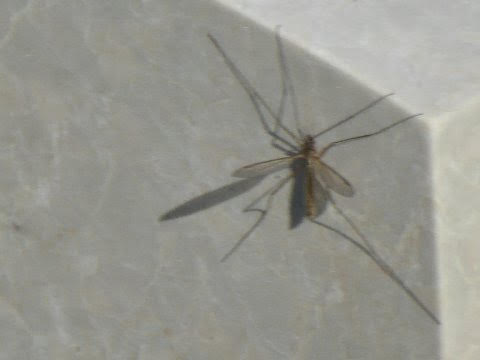
Above: Insect on headstone. Loos Memorial. Loos, France. 28 September 2015.
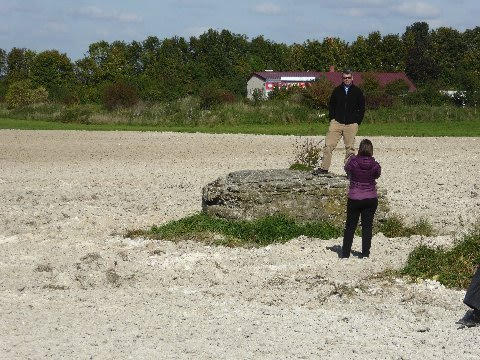
Above: Rudy Junior stands on WWI German bunker remnant while Portland captures an image. Loos Battlefield, Loos, France. 28 September 2015.
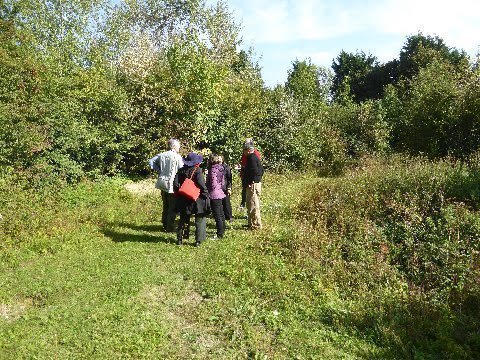
Above: Battlefield guide leads our group through the Hohenzollern Redoubt, a German strong point on the Hindenberg Line, Loos Battlefield. Loos, France. 28 September 2015.
The redoubt, in German hands through September of 1915, changed hands at the Battle of Loos.
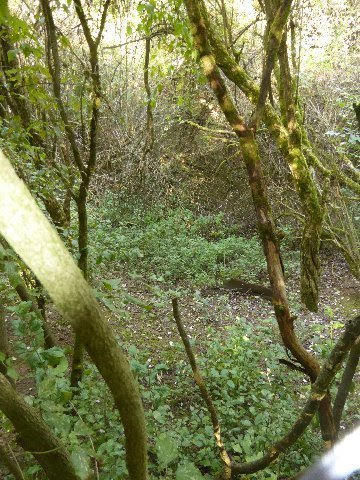
Above: Mine crater. Hohenzollern Redoubt, Loos Battlefield, Loos, France. 28 September 2015.
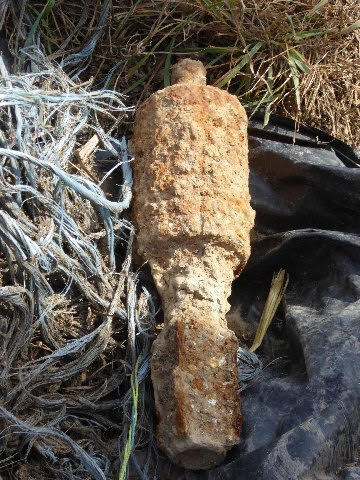
Above: German mortar ammo. Found in our wanderings through Hohenzollern Redoubt. Loos Battlefield. Loos, France. 28 September 2015.

Above: Patrick Mercer, battlefield guide, observes fuse from tip of 18 pound British round found by Portland near Hohenzollern Redoubt. Loos Battlefield. Loos, France. 28 September.
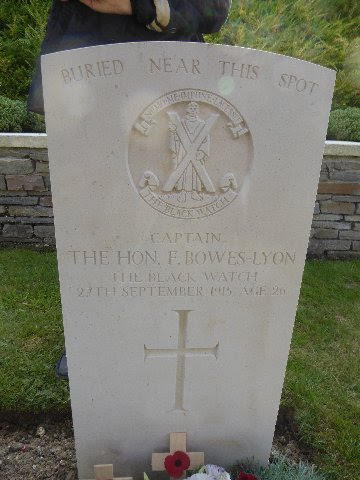

Above: Headstone at Loos Memorial cemetery for F. Bowes-Lyon, brother to The Queen Mother and uncle to Queen Elizabeth II. Loos, France. 28 September 2015.
The Commonwealth War Graves Commission has changed the commemoration for Captain Fergus Bowes-Lyon, an uncle of Her Majesty the Queen. Fergus died in France during the Battle of Loos in September 1915 and, until now, had been commemorated by the Commonwealth War Graves Commission on the Loos Memorial as he had no known grave.
His grandson wrote to the Commission in November 2011 after having visited Quarry Cemetery, Vermelles. He produced contemporary evidence that his grandfather had been buried in the quarry and that a grave marker with his name on it was still in place at the end of the war. The Commission's grave registration documents were found to record his burial in the cemetery in 1920, but these documents were superseded by the final grave registration forms, dating from 1925, which do not include Captain Bowes-Lyon's name.
Under these circumstances the Commission has agreed that the evidence for Captain Bowes-Lyon being buried in the cemetery is sufficient to allow the erection of a named headstone within the cemetery. The special memorial headstone to Captain Bowes-Lyon is inscribed 'Buried near this spot' as there is no certainty about the precise location of his remains within the cemetery. The majority of the headstones in Quarry Cemetery, Vermelles, are, in fact, of this type as the cemetery remained in the front line after 1915 and suffered extensive shell damage before the end of the war. This made precise grave identification extremely problematic.
The headstone was installed in the cemetery earlier this year.
Addendum:
SUPER !!
Mr. Z3,
Ojai, CA
Thank you Steve and Chitta for bringing WWI battle history to life for me.
Nathans,
Massapequa, NY
In the 1950's, when I was a high school student, my chemistry teacher was a gray-haired gentleman who had survived a German WW1 chlorine gas attack, losing one lung (the other was probably damaged as well).
He told us that just before demonstrating how to make chlorine gas (he performed the experiment in front of the class) and carefully instructing us how to smell its odor without injury (you fill your lungs with air, hold your breath, slightly open the containing vessel, and take a slight sniff). One after another, in groups of three, we followed his instructions, with no incident. Then, one of the students didn't follow instructions, and immediately collapsed. The teacher caught him, so he wasn't hurt from falling, and it turned out that he hadn't inhaled enough to cause any permanent damage.
When you inhale or are in contact with chlorine gas it reacts with the moisture in your eyes, nose, throat, windpipe, and lungs to form hydrochloric acid. You can imagine what that does, and the resulting pain.
Ain't war exciting? Guns, ammo, and all that great stuff.
FeeNix,
Phoenix, AZ
Just be glad you were not there during WW1.
There, but for the grace of God, go all of us.
FeeNix,
Phoenix, AZ
Hi Steve!
Thanks for sending me the pictures that included you at Independence Pass. Somewhere I have a picture of me taken there in 1950, during winter, when four of us were driving straight through from Chicago to spend the night in Glenwood Springs before arriving the next morning at Aspen for a week's vacation. The Eisenhower Tunnel was not started until 1968 so the pass on top was kept open all year long, as best they could, with giant snow plows. We managed to follow a plow and stopped long enough to have our picture taken at the sign at the top back then. The snow was deep but we made it.
There was one single chair lift to Aspen's top in two sections. As I remember you had to get off at the top of Ruthie's run (skiing down from there if you wished) or get back on to get all the way to the top of Ajax. The only other lift was a T-Bar up Little Nell at the base. Three years later I was back at Aspen for two nights on my Honeymoon to introduce my bride from Nashville to the place, on a trip from Palm Springs to our apartment in Evanston, stopping in Sun Valley for four days and her first time on skis. Fortunately she loved skiing and became better at it than was I.
By the way I expect to be back on the slopes for a half day a couple of times next winter to prove I did a bit when I was 91. I have fun telling old friends in Nashville (where i will be giving a couple of talks next month on my Man- hattan Project experience) that I still ski. They typically express amazement with "You still ski?" My also typical response is "Well I get tired a little just walking across the street to the mailbox. But you know ... skiing is all down hill!
Regards, Manhattan, Park City, UT